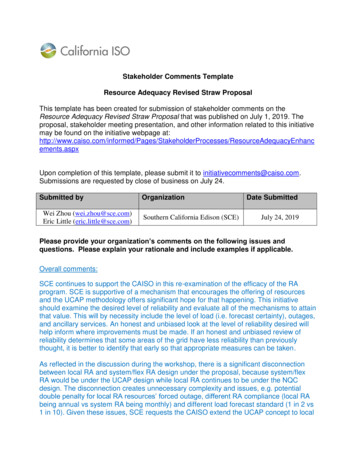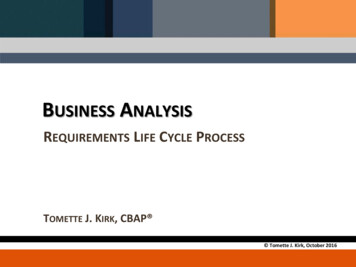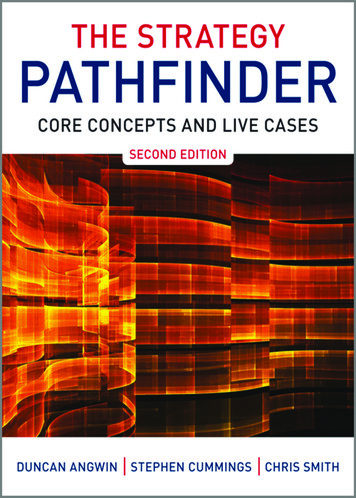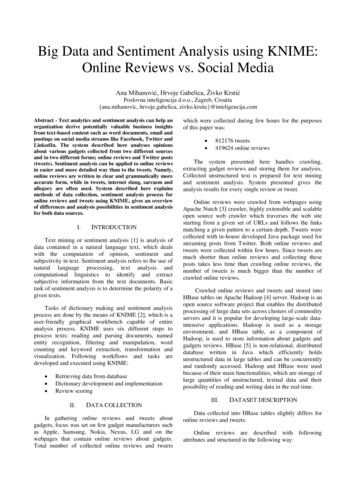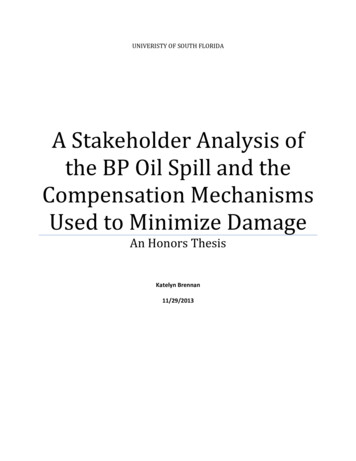
Transcription
UNIVERISTY OF SOUTH FLORIDAA Stakeholder Analysis ofthe BP Oil Spill and theCompensation MechanismsUsed to Minimize DamageAn Honors ThesisKatelyn Brennan11/29/2013
AbstractThe BP oil spill released 4.9 million barrels of oil into the Gulf of Mexico and caused a grave amount ofdamage to the surrounding areas both environmentally and economically. The states most impactedwere Louisiana, Mississippi, Alabama, Texas, and Florida. The main stakeholders in relation to the spillwere the environment, wildlife, fisherman, the oil industry, and tourist-driven businesses andcommunities. Directly following the spill, BP set up The Gulf Coast Claims Facility (GCCF) which was laterdeemed not independent and later replaced by a court supervised settlement program which took thesubjectivity of the eligibility out of the equation. Three years after the oil spill, BP announces that thecompensation fund was running low but they would continue to pay the settlements from their profits.Yet BP attempts to stem the flow of incoming claims using several methods, including suing the courtappointed administrator and appealing claims. In January 2013, BP pleads guilty to 11 counts of felonymanslaughter, one count of felony obstruction of Congress, and violations of the Clear Water andMigratory Bird Treaty Acts. BP was sentenced to pay 4 billion in fines and penalties. The DeepwaterHorizon Oil Spill has shown that the regulation for spill prevention and response are not sufficient. Asthe oil companies will act in the best interest of themselves, it is the duty of the government to setregulation in place in the interest of the health and safety of its citizens. The government needs to act tocreate tighter controls on oil companies to decrease the likelihood of a repeat occurrence.1
Table of ContentOverview of the BP Oil Spill . 3Stakeholder Theory . 5Environmental Impact. 6Economic Impact. 7Compensation Mechanisms . 9BP Compensation Mechanisms. 9Economic and Property Damages Settlement . 12Corporate Responsibility . 21BP’s Responsibility . 22Criminal Charges . 23BP’s Response . 28Action Needed . 33Works Cited . 38Table of FiguresFigure 1: Oil Spills by Size . 4Figure 2: Stakeholders of the BP Oil Spill . 5Figure 3: Medical Geographic Zones. 11Figure 4: Economic Loss Zones . 12Figure 5: Summary of Damage Categories. 13Figure 6: Eligible Geographic E&PD Settlement Zones . 15Figure 7: Fixed and Variable Costs for Claim Purposes . 17Figure 8: Risk Transfer Premium Rates . 18Figure 9: Administrative and Accounting Fee Reimbursement . 19Figure 10: BP Stock Prices . 22Figure 11: A Brief Summary of the BP Oil Spill Effects . 26Figure 12: Criminal Charges: Fines and Penalties . 27Figure 13: Income Statement . 352
Overview of the BP Oil SpillOn April 20, 2010, the Deepwater Horizon oil rig exploded. While the fire on theplatform was still being contained Transocean and BP were assessing their options.Transocean is the company that owned and staffed the Deepwater Horizon rig. BP is thecompany who leased and provided the supervisors aboard the rig, in addition to being 65%owner of the Macondo oil well. The Macondo well had been damaged in the explosion andwas leaking oil into the Gulf of Mexico. The well contained over 110 million barrels of oiland was greater than 13,000 feet below sea level (Cleveland, 2010). The well discharged oilinto the Gulf of Mexico for eighty-seven days until the attempt to cement the well shut wassuccessful, but at that point the damage was already done. An estimated 4.9 million barrelsof oil was released into the Gulf, contaminating the waters and surrounding shorelines(Federal On-Scene Coordinators, 2011).After the spill, a federal joint task force was assigned to determine the cause of theoil spill. They concluded that BP, Transocean and Halliburton, the contractor used to sealthe damaged well, shared responsibility for the explosion and consequent damages, butthat BP was "ultimately responsible".BP has a history of misconduct. They have had 63 reported incidents of misconductsince 1995 (Sheppard, 2013). These prior health and safety violations resulted in anexplosion in a Texas refinery in 2005 and a fire in an Ohio refinery in 2006. These instanceskilled 30 people and injured over 200 others. For three years, from 2007 to 2010, BP’shealthy and safety violations made up 97% of the "egregious, willful" violations issued bythe Occupational Safety and Health Administration (OSHA) (Thomas, Cloherty, & Ryan,2010).3
In April 2011, BP and Halliburton sued each other claiming that the other wasresponsible for the disaster, including the explosion and resulting leak. A federal judgeruled that Halliburton was not liable, leaving BP responsible for all claims. Similarly, inJanuary 2012, it was ruled that Transocean was only liable for fines under the Clean WaterAct and its share of punitive damages, not economic loss claims.As displayed by Figure 1, The BP oil spill is not the largest spill by volume but it hashad one of the worse impacts due to its location in the Gulf of Mexico near a number ofmajor metropolitan areas. The stakeholders of the oil spill are widespread, varying fromindividuals and businesses to the environment and entire industries. BP Chief Executive,Tony Hayward, stated shortly after the spill that "we are taking full responsibility for thespill and we will clean it up and where people can present legitimate claims for damageswe will honor them" (Cleveland, 2010).Figure 1: Oil Spills by Size(Potenza, 2010)4
Stakeholder TheoryStakeholder theory simply states that the stakeholders of a company are not just itsdirect owners but that stakeholders are any person, group or entity that a corporation has“benefited or burdened by its actions and those who benefit or burden the firm with theiractions” (Steiner, 2012; Miles, 2012).The first stakeholders impacted by the Deepwater Horizon Oil Spill were theworkmen on the rig itself. When the rig exploded 126 people were on the platform, only115 were evacuated (Cleveland, 2010). After a three day search covering 5,200 miles, theCoast Guard called off the rescue operation stating that the period for “reasonableexpectations of survival” had passed. Sadly, the 11 presumed dead members of the crewwould not be the only ones impacted by this tragedy. Other major stakeholders include, theenvironment, the Gulf fishing industry, and tourist-dependent businesses and communities.Figure 2: Stakeholders of the BP Oil Spill(Brennan, 2013)TouristsOil Spill CleanUp stsTourist-drivencommunitiesStakeholders inthe BP Oil SpillGovernmentFishermanMediaEnvironmentOil Industry5
Environmental ImpactThe environment is always a stakeholder in oil spills. The environmental impact ofan oil spill on sea organisms and their ecosystems has been well-documented. The OilPollution Act of 1990 mandates that a Natural Resources Damage Assessment be compiledfor each oil spill. The assessment allows restoration efforts to be completed in the areas ofmost need by measuring the impact in terms of fish killed and wetland destroyed. Thereport compiled for the BP oil spill states that approximately 1,100 miles of coastal wetlandwere victim to the effects of the spill (National Academy of Sciences, 2013). It wasdetermined that areas where vegetation and root systems were eradicated by the spill,erosion will convert marshland into open water.The U.S. Fish and Wildlife Service determined that 32 National Wildlife Refuges areat risk as a result of the oil spill, including Breton National Wildlife Refuge, the secondoldest refuge in the country (Cleveland, 2010).Oil can cause harm through physical contact, inhalation, and absorption. Ingestion ofoil by marine animals has shown organ damage, ulceration, lowered immune systems, skinirritation, and changes in behavior. For three years, from 2010 through 2012, 817bottlenose dolphin deaths were reported compared to a steady average of 100 deaths peryear that was documented during the previous seven years, between 2002 and 2009(National Academy of Sciences).BP used a variety of known methods to minimize the amount of oil that would reachshore, including burning, skimming, and chemical dispersants. These methods were veryeffective in decreasing the volume of the oil by as much as 40%, but the long term effects ofthese techniques to the oceanic ecosystems remains unknown (National Academy of6
Sciences). It is apparent that the effects of this spill will continue to be seen for years tocome.Economic ImpactThe economic impact is still not fully known. Many different stakeholders wereeconomically affected as a result of the spill, both directly and indirectly. Fisherman in thearea, as well as hotels, restaurants, and other businesses tied to tourism, felt the mostimmediate effect. The commercial production of fish decreased by 20% due to fisheryclosures (National Academy of Sciences). In 2008, commercial fisherman in the Gulfharvested over 1 billion pounds of fish and shellfish (Cleveland, 2010). Now the safety ofseafood harvested from the Gulf is in question leaving the livelihood of Gulf fisherman in aprecarious situation.With the heavy media coverage, including images of the ruined coastline and thefrequency of tar balls appearing on shore, positive public perception and tourism in theGulf of Mexico has declined. One year after the spill, rental reservations were still down byover 25% (Jones, 2011). Companies, especially those involving excursions into the water,such as scuba diving and sailing, are under constant question as to whether there is still oilin the water. Eilene Beard, a local business owner in Pensacola, FL, stated that people whocall usually ask multiple times if she is sure that the water is safe. She believes that what iskeeping tourists away is the constant uncertainty of the quality of the water (Jones, 2011).Areas such as Fort Meyers, where tourism shouldn’t have been impacted by the oilspill, as surface oil never appeared on their shores, also experienced a significant decreasein the amount of tourism due to negative public perception of tainted waters and shores.Although the area was not directly affected, BP paid 500,000 to Lee County in order assist7
with the cost of advertising. Lee County spent over 1,250,000 in advertising to attempt tocounteract the negative public opinion of the area without satisfactory success (Finn,2013). Lee County Tourism Bureau Director, Tamara Pigott, stated that she didn’t feel thatthe 500,000 BP paid benefitted them as much as counties that were directly impacted bythe spill and had that received more money. "Tourism doesn't happen on its own, it takesmarketing dollars, particularly if you're battling an image crisis like the oil spill," NewOrleans convention and visitor bureau spokeswoman Kelly Schultz said (Reuters, 2012). Asof May 2013, BP has spent over 150 million into promoting the Gulf areas in an attempt tobring tourism back to the region. It is expected that an additional 30 million will be paidby the end of 2013 (Reuters, 2012).Three years after the disaster, tourism seems to be making a comeback in the Gulfarea. A study by Smith Travel Research, Inc., an international market analyst group, showsthat occupancy in hotels within 10 miles of the Gulf was 11% higher in the first quarter of2013 than in the first quarter of 2010, the period directly preceding the oil spill (Finn,2013). According the Walton County Tourism Director, Jon Ervin, hotel room tax revenuehas increased by 60% since 2010.8
Compensation MechanismsOil spill regulations are enforced by federal, state, and international parties. Theresponsibilities are divided into two different categories: 1) Response and cleanup and 2)prevention and preparedness. Responsibility for response and cleanup is determined bythe location of the spill. If the spill occurred in a U.S. coastal area, the U.S. Coast Guard hasjurisdiction, whereas if it occurred in an inland zone, the Environmental Protection Agency(EPA) has jurisdiction. Responsibility for prevention and preparedness is determined bythe source of the oil spill, meaning vessel, facility, pipeline, etc.The annual number and volume of oil spills has decreased over time from 1973 to2009 (Ramseur, 2013). The Exxon Valdez spill in 1989 was a significant instigator ofstronger legislation and public awareness. The resulting legislation was the Oil PollutionAct of 1990 which was passed by Congress. This law clarified and increased the authoritythat the federal government had over the prevention and response to oil spills.BP Compensation MechanismsVictims of oil spills have few methods available to them for receiving monetarycompensation. To recover from any financial losses sustained due to the BP oil spill in 2010their options are 1) an individual law suit in civil court, 2) a class-action law suit in civilcourt, or 3) the court approved settlement.After the disaster, BP was under a lot of pressure to create a solution that wouldsatisfy the negatively impacted stakeholders in a timely manner. The Deepwater HorizonOil Spill was highly publicized; not a day went by that a story didn’t appear in the newsabout the catastrophe that had occurred off the shore in the Gulf of Mexico. BP was under9
pressure from state and federal government as well as the general public to answer for thedisaster. In response, BP created a compensation fund.Previously, the Oil Pollution Act of 1990 had required that companies set aside afund of 1 billion from which the company would provide compensation to injured parties.Politicians knew that this sized fund would not appease the public given the currentsituation. Therefore, a 20 billion fund was agreed upon for the Deepwater Horizon OilSpill.Initially, the Gulf Coast Claims Facility (GCCF) was formed by BP to process the flowof claims coming in. The GCCF was to be administrated by Kenneth Feinberg, who had beenpart of the 9/11 compensation fund, Aurora Victim Relief Fund, the Penn State Settlementin regards to the sexual abuse victims by the assistant football coach, and the One Fund forthe victims of the Boston marathon bombing (Partlett & Weaver, 2011; Cohen, 2013). Itwas later deemed by a federal judge that Feinberg was not an objective administrator as hisfirm was being paid by BP. It was proven that both his firm and BP had made the terms ofthe compensation plan purposefully vague. In response, the GCCF was disbanded andreplaced with a court supervised settlement agreement to be administrated by PatrickJuneau. The new agreement had detailed terms that removed the subjectivity of theeligibility of claimants and the corresponding compensation amount. Due to the lack ofsubjectivity, there have been allegations that claimants have abused the methods used inthe settlement programs.The court supervised settlement has multiple settlement programs including aMedical Benefits Class Action Settlement and an Economic and Property DamagesSettlement (E&PD). The Medical Benefits Settlement is for either clean-up workers or10
residents of beachfront areas and wetlands present during certain time periods in 2010who reside in the United States as of April 16, 2012 (Deep Horizon Court-SupervisedSettlement Program, 2012). As described on the official Deep Horizon Court-SupervisedSettlement Program website, this settlement offers three main benefits:1) A compensation program for specific physical conditions (See Specified PhysicalConditions);2) A periodic medical consultation program; and/or3) A provision of back end litigation option process for later-manifested physicalconditions.For eligibility a claimant must have been a clean-up worker between April 20, 2010and April 16, 2012, resided in “Zone A” (See Figure 3) for at least 60 days between thedates of April 20, 2010 and September 30, 2010 and have a “specified physical condition”prior to the September date, or lastly resided in “Zone B” (See Figure 3) for 60 daysbetween April, 20, 2010 and December 31, 2010.Figure 3: Medical Geographic Zones(Deep Horizon Court-Supervised Settlement Program, 2012)11
Economic and Property Damages SettlementAs found on the official Deep Horizon Court-Supervised Settlement Programwebsite, the “Economic and Property Damages Settlement Agreement” was amended onApril 18, 2012. It states that to be categorized within the E&PD Settlement Class, you mustbe a natural person or entity that is within the geographic zones (See Figure 4) and have aclaim that meets one of the Damage Categories (See Figure 5).Figure 4: Economic Loss Zones(Deep Horizon Court-Supervised Settlement Program, 2012)12
Figure 5: Summary of Damage Categories(Deep Horizon Court-Supervised Settlement Program, 2012)Damage CategorySEAFOOD COMPENSATION PROGRAMECONOMIC DAMAGE CATEGORYSUBSISTENCE DAMAGE CATEGORYVoO CHARTER PAYMENT CATEGORYVESSEL PHYSICAL DAMAGE CATEGORYCOASTAL REAL PROPERTY DAMAGECATEGORYWETLANDS REAL PROPERTY DAMAGECATEGORYREAL PROPERTY SALES DAMAGECATEGORYINDIVIDUALS/EMPLOYEES IN OTHERWISEEXCLUDED OIL AND GAS, GAMING,BANKING, INSURANCE, FUNDS, DEFENSECONTRACTORS, DEVELOPERS INDUSTRIES,AND ANY ENTITY SELLING OR MARKETINGBP-BRANDED FUELINDIVIDUALS/EMPLOYEES IN SUPPORTSERVICES TO OIL AND GAS INDUSTRYBUSINESSES/EMPLOYERS IN OTHERWISEEXCLUDED GAMING, BANKING,INSURANCE, FUNDS, DEFENSECONTRACTORS AND DEVELOPERSINDUSTRIESBUSINESSES/EMPLOYERS IN SUPPORTSERVICES TO OIL AND GAS INDUSTRYWho’s EligibleCommercial fisherman, seafood crew, orseafood vessel ownerNatural persons or entities who had a loss ofincome, earnings or profitsNatural persons who fish or hunt to harvest,catch, barter, consume or trade Gulf ofMexico natural resourcesNatural persons or entities who suffereddamages and registered for BP’s Vessels ofOpportunity (VoO) program, executed a VoOMaster Vessel Charter Agreement, andcompleted the initial VoO training programNatural persons or entities whose eligiblevessel sustained physical damageNatural persons or entities whose coastalreal property was damagedNatural persons or entities whose wetlandreal property sustained physical damageNatural persons or entities who had a loss ofincome, earnings or profits due to an impacton real property salesIndividuals or employees in otherwiseexcluded oil and gas, gaming, banking,insurance, funds, defense contractors,developers industries, and any entity sellingor marketing BP-branded fuel that had aloss of income, earnings or profitsIndividuals or employees in supportservices to oil and gas industry that had aloss of income, earnings or profitsBusinesses or employers in otherwiseexcluded gaming, banking, insurance, funds,defense contractors and developersindustries that had a loss of income,earnings or profitsBusinesses or employers in support servicesto oil and gas industry that had a loss ofincome, earnings or profits13
Either a natural person or an entity may file a claim from the E&PD Settlement. Anatural person is defined as an individual who lived, worked, were offered and acceptedwork, owned or leased real or personal property located, owned or leased or worked on avessel harbored or home ported in the eligible geographic zones listed below (See Figure 4)between April 20, 2012 and April 16, 2012 (Deep Horizon Court-Supervised SettlementProgram, 2012).Entities, for claim purposes, are all entities doing business or operating in theeligible geographic zones (See Figure 4) that sold products to consumers or other entities,regularly purchased seafood from specified gulf waters, are service businesses with one ormore full-time employees, owned, operated, or leased a vessel that was home ported,landed seafood, or owned or leased real property in the Gulf Coast Area between April 20,2010 and April 16, 2012 (Deep Horizon Court-Supervised Settlement Program, 2012).The eligible geographic zones include: Louisiana, Mississippi, Alabama, Texas, the counties of Chambers, Galveston, Jefferson and Orange Florida, the counties of Bay, Calhoun, Charlotte, Citrus, Collier, Dixie,Escambia, Franklin, Gadsden, Gulf, Hernando, Hillsborough, Holmes, Jackson,Jefferson, Lee, Leon, Levy, Liberty, Manatee, Monroe, Okaloosa, Pasco, Pinellas,Santa Rosa, Sarasota, Taylor, Wakulla, Walton and Washington.14
Figure 6: Eligible Geographic E&PD Settlement Zones(Horizon Court-Supervised Settlement Program, 2012)Non-eligible claimants include defense contractors or subcontractors, industriesthat fall under specific excluded North American Industry Classification System (NAICS)codes, any entity selling or marketing BP-branded fuel, government organizations, or anynatural person or entity that has previously made a claim to the GCCF. Defense contractorsand subcontractors are defined as firms which generate over 50% of their annual revenue15
from contracts with the United States Department of Defense and individuals whoseemployers qualify as a defense contractor. The excluded NAICS codes fit under threecategories: Oil & Gas Industry Exclusions, Industry Types Subject to Review by ClaimsAdministrator for Potential Moratoria Losses, or Economic Loss and Property ClassDefinition Exclusions (See Excluded Industry Chart).The base claim is determined by calculating the change in profit, excluding fixedcosts. The list approved by BP for fixed and variable expenses can be seen in Figure 7. Theallegations of abuse of the Economic and Property Damages program by claimantsoriginate from the wording used in the settlement. The methods detailed within are tocalculate the “economic loss” regardless of its connection to the negative effects of the BPoil spill .When calculating the exact amount owed to a claimant for damages, a RiskTransfer Premium (RTP) is added to the base amount. The RTP is the amount paid to aclaimant above the cost of damages to compensate for potential future injuries, damages, orlosses that may arise from or be related to the Deepwater Horizon Incident. The monetaryamount of the RTP depends on multiple factors, including the base compensation amount,the economic zone, and the type of claim. See Figure 8 for a summary of the applicableRTPs.16
Figure 7: Fixed and Variable Costs for Claim Purposes(Horizon Court-Supervised Settlement Program, 2012)17
Figure 8: Risk Transfer Premium Rates(Deep Horizon Court-Supervised Settlement Program, 2012)18
BP will also provide reasonable compensation for administrative costs, accountingfees, and other out of pocket fees that arise in direct relation to the settlement program(See Figure 9). Both individual claimants and business claimants are reimbursed based onthe actual accounting fees incurred. Individuals with claims under 10,000 may onlyreceive up to 200 in reimbursements while businesses with claims under 50,000 mayonly receive up to 1,000. For claims above the mentioned threshold no more than 2% ofthe base claim may be reimbursed for accounting fees (Deep Horizon Court-SupervisedSettlement Program, 2012).Figure 9: Administrative and Accounting Fee Reimbursement(Deep Horizon Court-Supervised Settlement Program, 2012)What the court-supervised settlement doesn’t include in the compensation amountis the percentage that goes to the parties working on the claim, such as the accounting firmthat prepares the eligible loss amount and the law firm that files and goes through theappeal process. These firms work on a contingency fee, meaning they only receive paymentif and when the claimant does. The law firms handling the settlement can receive up to25% of the total claim in legal fees (Cohen, 2013).19
On Tuesday July 30, 2013, BP admitted that the Deepwater Horizon Oil Spill Trustfund had almost run out of money. BP has increased its estimate on the amount of cashneeded to compensate individuals and businesses from 8.2 billion to 9.6 billion. Thatmeans, as of July 30, 2013, only 300 million remains in the fund (Channel News Asia,2013). BP intends to pay the remaining claims from income made in the third quarter offiscal year 2013.20
Corporate ResponsibilityCorporate Social Responsibility (CSR) is the concept of corporate self-regulation toensure compliance with the law and ethical standards. Many oil corporations have workedCSR values into their companies’ core values, including Chevron, Marathon, and Indian Oil,but it is not mandatory (Chevron Corporation, 2013; Marathon Oil Corporation, 2013;Indian Oil Corporation Ltd., 2013). In a utopian world, corporations would hold themselvesresponsible, but at present it’s the duty of the government and legal system to ensureprevention mechanisms are in place and that injured parties are compensated.The real question is whether or not BP can ever really be made to pay for all of thedamage caused by their negligence in the Gulf. According to the International TankerOwners Pollution Federation Limited (ITOPF), there is no simple answer when it comes tothe cost of oil spills since it varies from one incident to the next and depends on the numberof interrelated factors such as the type of oil, the location of the spill, and the attributes ofthe disturbed area, as well as the quality of the contingency plan and actual response ofmanagement. The most expensive oil spill in history pre 2010 is the Exxon Valdez spillwhich occurred in Alaska in 1989. The total cost including fines, penalties, and claimsettlements was estimated at 7 billion. A significant portion of that, 2.5 billion, wasattributed to cleanup costs alone.The International Tanker Owners Pollution Federation Limited states that “Thetendency to react to political, media and public perceptions and pressures, rather thanbasing decisions on technical realities, is a special problem that can also escalate the cost ofany incident beyond what would be considered ‘reasonable’ under the internationalcompensation conventions.” (ITOPF)21
BP’s ResponsibilityBP estimates the total bill for the disaster, including clean-up and fines will total 42.4 billion. Yet the question that remains is whether the government and legal systemare properly holding large corporations accountable when less than three years aftercausing an environmental and economic disaster they continue to earn billions in profit.Large companies, such as BP, can easily write off the irreparable environmental harm as acost of doing business.As you can see in in Figure 11, BP stock prices decreased directly following the spillbut within a couple months the prices rose once again. Although the prices are not wherethey were pre-spill it is not unreasonable to say that the stock will recover its original valuewithin the next couple years.Figure 10: BP Stock PricesGoogle Finance: BP Stock Prices(Google, 2013)Yahoo Finance: BP Stock Prices(Yahoo, 2013)22
Criminal ChargesThe events that occurred in the Gulf in 2010 can put BP in 2 legal arenas – civil courtand criminal court. On January 29, 2013, BP’s criminal plea agreement for its illegalconduct leading to and following the 2010 Deepwater Horizon Oil Spill was accepted. BP ispleading guilty to
at risk as a result of the oil spill, including Breton National Wildlife Refuge, the second oldest refuge in the country (Cleveland, 2010). Oil can cause harm through physical contact, inhalation, and absorption. Ingestion of oil by marine animals has shown organ damage, ulceration, lowered

